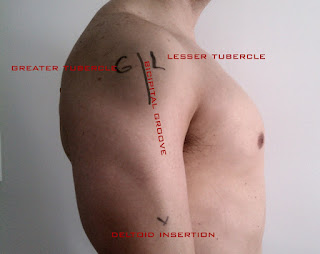In human anatomy, the deltoid muscle is the muscle forming the rounded contour of the shoulder.
Anatomically, it appears to be made up of three distinct sets of fibers though electromyography suggests that it consists of at least seven groups that can be independently coordinated by the central nervous system.
It was previously called the Deltoideus and the name is still used by some anatomists.
It is called so because it is in the shape of the Greek letter Delta (triangle).
It is also known as the common shoulder muscle, particularly in lower animals (e.g., in domestic cats).
Deltoid is also further shortened in slang as "delt". The plural forms of all three incarnations are deltoidei, deltoids and delts.
A study of 30 shoulders revealed an average weight of 191.9 grams (6.77 oz) (range 84 grams (3.0 oz)–366 grams (12.9 oz)) in humans.
Origins
Fick divided these three groups of fibers, often referred to as parts (Latin: pars) or bands, into seven functional components:the anterior part has two components (I and II); the lateral one (III); and the posterior four (IV, V, VI, and VII) components. In standard anatomical position (with the upper limb hanging alongside the body), the central components (II, III, and IV) lie lateral to the axis of abduction and therefore contribute to abduction from the start of the movement while the other components (I, V, VI, and VII) then act as adductors.
During abduction most of these latter components (except VI and VII which always act as adductors) are displaced laterally and progressively start to abduct.
Insertion
Anatomically, it appears to be made up of three distinct sets of fibers though electromyography suggests that it consists of at least seven groups that can be independently coordinated by the central nervous system.
It was previously called the Deltoideus and the name is still used by some anatomists.
It is called so because it is in the shape of the Greek letter Delta (triangle).
It is also known as the common shoulder muscle, particularly in lower animals (e.g., in domestic cats).
Deltoid is also further shortened in slang as "delt". The plural forms of all three incarnations are deltoidei, deltoids and delts.
A study of 30 shoulders revealed an average weight of 191.9 grams (6.77 oz) (range 84 grams (3.0 oz)–366 grams (12.9 oz)) in humans.
Human anatomy
- The anterior or clavicular fibers arises from most of the anterior border and upper surface of the lateral third of the clavicle.
- The anterior origin lies adjacent to the lateral fibers of the pectoralis major muscle as do the end tendons of both muscles. These muscle fibers are closely related and only a small chiasmatic space, through which the cephalic vein passes, prevents the two muscles from forming a continuous muscle mass.
- Lateral or acromial fibers arise from the superior surface of the acromion process.
- They are commonly called lateral deltoid. This muscle is also called middle delts, outer delts, or side delts for short.
- They are also mistakenly called medial deltoid,which is wrong, as their origin is the least medial portion of the deltoid.
- Posterior or spinal fibers arise from the lower lip of the posterior border of the spine of the scapula.
- They are commonly called posterior deltoid or rear deltoid (rear delts for short ).
Fick divided these three groups of fibers, often referred to as parts (Latin: pars) or bands, into seven functional components:the anterior part has two components (I and II); the lateral one (III); and the posterior four (IV, V, VI, and VII) components. In standard anatomical position (with the upper limb hanging alongside the body), the central components (II, III, and IV) lie lateral to the axis of abduction and therefore contribute to abduction from the start of the movement while the other components (I, V, VI, and VII) then act as adductors.
During abduction most of these latter components (except VI and VII which always act as adductors) are displaced laterally and progressively start to abduct.
Insertion
From this extensive origin the fibers converge toward their insertion on the deltoid tuberosity on the middle of the lateral aspect of the shaft of the humerus; the middle fibers passing vertically, the anterior obliquely backward and laterally, and the posterior obliquely forward and laterally.
Though traditionally described as a single insertion, the deltoid insertion is divided into two or three discernible areas corresponding to the muscle's three areas of origin.
The insertion is an arch-like structure with strong anterior and posterior fascial connections flanking an intervening tissue bridge.
It additionally give off extensions to the deep brachial fascia.
Furthermore, the deltoid fascia contributes to the brachial fascia and is connected to the medial and lateral intermuscular septa.
The insertion is an arch-like structure with strong anterior and posterior fascial connections flanking an intervening tissue bridge.
It additionally give off extensions to the deep brachial fascia.
Furthermore, the deltoid fascia contributes to the brachial fascia and is connected to the medial and lateral intermuscular septa.
Action
When all its fibers contract simultaneously, the deltoid is the prime mover of arm abduction along the frontal plane.The arm must be medially rotated for the deltoid to have maximum effect[citation needed]. This makes the deltoid an antagonist muscle of the pectoralis major and latissimus dorsi during arm adduction.
The anterior fibers are involved in shoulder abduction when the shoulder is externally rotated.
The anterior deltoid is weak in strict transverse flexion but assists the pectoralis major during shoulder transverse flexion / shoulder flexion (elbow slightly inferior to shoulders).
The anterior deltoid also works in tandem with the subscapularis, pecs and lats to internally (medially) rotate the humerus.
How To Stretch Shoulder Or Deltoid Muscles
How to do a Shoulder Pike Press Workout for Anterior Deltoid Muscle
Shoulders workout video | Rear Delt Rises | muscle growth
Deltoid Muscles Exercise Dumbbell Side Lateral Raises
How To Give Intramuscular Injection In Deltoid Muscle?
How to draw shoulders/deltoid
How to Give a Sports Massage : Finding Injuries in the Deltoid Muscles Using Sports Massage
How To Build / Gain Muscle Fast HOME SHOULDER WORKOUT!!!
Seated Dumbbell Press for Shoulders & Deltoids
Dumbbell Front Raise















.jpg)

.jpg)



.jpg)




























0 comments